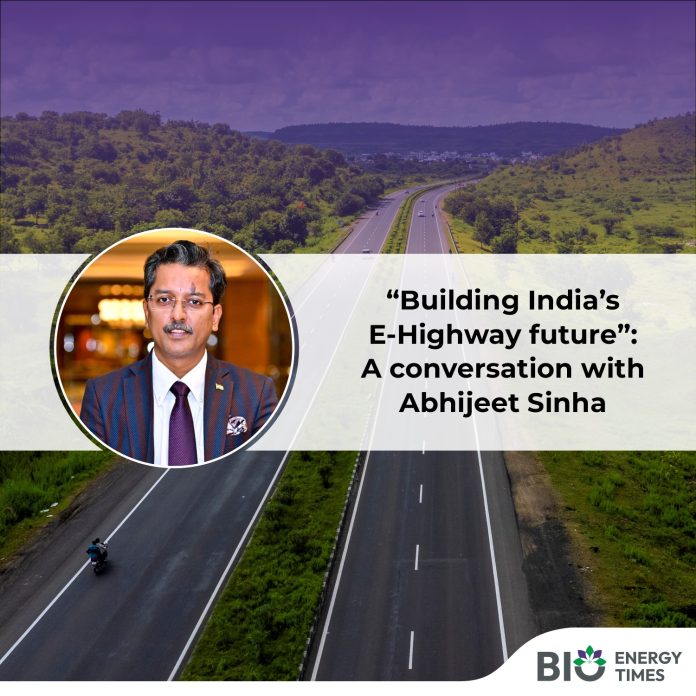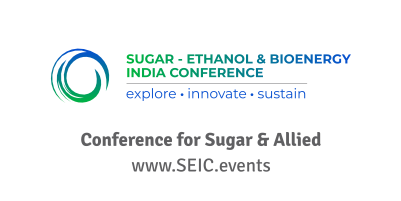India (Bharat) is taking steps to emerge as a global leader in electric vehicle (EV) adoption and technological innovation, driven by an ambitious national vision for sustainable mobility and energy independence. Spearheaded by supportive government policies, robust infrastructure development, and a growing ecosystem of pioneering projects, the country is transforming its transportation landscape, with initiatives like the National Highway for Electric Vehicle (NHEV) serving as prime examples of this momentum. At the heart of this transformation is Mr. Abhijeet Sinha, Project Director of NHEV, whose extensive experience, from shaping campaign strategies with Prime Minister Modi’s Citizen for Accountable Governance (CAG) team to heading India’s premier tech-piloting agency, positions him at the forefront of facilitating ‘Ease of Doing Business’ for emerging and deep technologies. In this conversation, he shares with Prakash Jha the challenges, strategies, and milestones that are defining Bharat’s e-mobility future, in an exclusive interview with Bioenergy Times.
Q. You have transitioned from PM Modi’s 2014 campaign’s CAG team to now ‘Ease of Doing Business’ ; heading India’s premier emerging tech-piloting agency; How has your experience in the ‘Citizen for Accountable Governance’ (CAG) team shaped your approach to start India’s 1st emerging tech piloting agency extending ‘Ease of Doing Business’ critically to emerging tech adoption and deep tech transitions?
My experience with the Citizen for Accountable Governance (CAG) during the 2014 campaign and 2nd & 3rd term campaigns Mai Bhi Chowkidar (2019) and Viksit Bharat (2024), has been foundational in shaping my approach to lead India’s premier tech-piloting agency. In the CAG team, I learned the immense value of citizen participation, stakeholder inclusivity, and the importance of ‘democratized’ policy making for accountable and transparent governance in the social and commercial landscape.
We campaigned at the grassroots level, engaging with diverse communities, social classes, income groups, and stakeholders, from the dynamic environment of Vibrant Gujarat to those few states that were then considered less attractive for investment. These experiences instilled in me the conviction that a data-driven policymaking culture is essential to overcoming the challenges of implementation, precision, and efficacy that often hinder effective competitive federalism and governance.
Taking this hot seat to lead ‘Ease of Doing Business’ piloting agency and extending advanced-level technical and commercial piloting services to our emerging and deep tech ambitions, was like fire cooking on a hot plate, that too from outside the government. Where a thin margin of error demands precision and merit-based endorsement, any tech-pilot gone wrong can throw the entire agency under the bus for tight scrutiny. But incentives to build it right and being a successful piloting agency would methodologically BUILD and FORM an entire generation of Tech Piloting agencies in various sectors to pull India out from the era of assumptive commercial, industrial and social policy making into a new age Bharat that becomes ready to Perform and Transform to a Viksit Bharat.
Q. Your efforts to extend ease of doing business is horizontally applicable on cross-sectoral micro economies. But it seems you have majority of your EoDB pilot projects and Viksit Bharat tech ambitions around energy and that too towards energy transition to cleaner, greener and eventually net zero. Is it your personal choice or there is more to it for us to, see?
It’s very hard statement to make but it’s true that PM Modi has made India’s energy independence transition a top strategic priority in his 3rd term. You may have seen digital economy & UPI shining everywhere, unanimously across the state and national electoral campaigns getting acknowledged. But today if there are 3 – 4 top national priorities that PM wish to strategically focus in MODINOMICS 3.0 then energy transition is on top of them.
Major national ambitions and missions associated with the Viksit Bharat 2047 milestone were only introduced to us in 2022, when Bharat officially entered into the AmritKal (2022 – 2047), the final 25-year time window of its century as a democratic nation. But PM essentially started working on it immediately after 2019 election and his first bold statement that took lot of homework, phased planning in milestone segmentation came out in August 2021; that India to become energy independent by the country’s 100th year of independence, outlining a roadmap to 2047 involving a gas-based economy, ethanol blending, electric mobility, and a push for renewable energy, including the launch of the National Hydrogen Mission.
Personally, I had the privilege to understand its strategic and geo political importance from our CDS Late Gen. Bipin Rawat in November 2020 when NHEV (National Highway for Electric Vehicle) conducted its first technical trial of Indian E-highway between India Gate Delhi and Agra. His participation, as Chief Guest was deliberately linked by misanthropes with ongoing border tensions with China, just because few of the participating auto makers like MG Motors were of Chines origin then. Though MG Motor tried to cover its Chinese links with this sponsored sabotage and tried to escape further investigations. But still there are evident reports exist that China did play a role in intersecting India’s E-Highway ambitions.
An ambitious project of national importance like NHEV suffered unnecessary delay due to this Chinese decussate but gave us a brutal lesson of clarity. That our technical, commercial and industrial policymaking tools and means has now got compromised to a dangerous level. That China or foreign countries with vested interest and funded companies can easily damage our energy transition trajectory with such cross border sponsored distractive narratives; if not scrutinized and democratized with an evidence based and data driven approach. After suffering significant time loss finally NHEV got a go ahead from the Govt in 2024 for a national roll out with recommendations from 34th Parliamentary Committee on Estimates report in 14th Lok Sabha on the Evaluation of Electric Vehicle (EV) Policy and currently its upgrading 5500 km Bharatmala & Sagarmala routes in E-highways connecting 26 cities and 14 states.
Q. Before we deep dive in NHEV pilot project, would you like to outline major ambitions, enablers, challenges and trajectories of ongoing national energy independence goals and constituents of this spectrum shift?
India’s national ambition, as articulated by PM Modi Cabinet, is to achieve full energy independence by 2047, an epochal target aligning with the centenary of Indian independence. This vision is not merely about reducing energy imports but about fundamentally transforming the energy spectrum toward mobility, sustainability, security, and global competitiveness. Major goals include decarbonizing the power sector, expanding renewable sources, boosting domestic manufacturing for green fuel, technologies, and creating a robust export industry around green hydrogen and ammonia. The government’s master plan calls for raising renewable energy capacity to 500GW by 2030, increasing the share of renewables in electricity generation to 50%, pushing 100% railway electrification, and building a powerful, integrated energy grid. These ambitions are also closely tied to overcoming chronic trade and current account deficits, curbing oil dependencies, and supporting India’s journey to become a top economic and manufacturing power.
Despite this bold ambition, India faces several substantial challenges on its energy independence path. The country is currently the world’s third-largest greenhouse gas emitter and has some of its most polluted cities. Fossil fuels still dominate India’s energy mix, with coal representing over 54% of supply and oil 29% as of 2023. Realizing independence requires massive scaling of renewables, yet many suitable renewable infrastructure locations are far from demand centres’, creating challenges in land acquisition and delays in building out the necessary transmission lines. Payment delays from state distribution companies, price negotiations in power purchase agreements, and rising costs for green equipment are additional barriers. Moreover, new core industries—such as green hydrogen and ammonia—remain at an early stage, facing both technological and pricing hurdles. India therefore accelerating affordable battery, storage, and micro nuclear capacity, while building a capable domestic manufacturing supply chain for critical equipment and minimizing persistent reliance on imported oil and natural gas.
India’s energy independence trajectory is marked by a blend of strategic reforms, clear milestones, and ambitious enablers. Key boosters include the National Green Hydrogen Mission, the PM Surya Ghar Muft Bijli rooftop solar initiative (targeting 10 million solarized homes by FY2026-27), expanded production-linked incentives (PLI) for local manufacturing of renewables, and aggressive regional collaboration for power trading and import of hydropower from neighbouring countries. Pumped storage, large-scale battery rollouts, and increased nuclear capacity further diversify the energy mix. Regulatory frameworks like renewable purchase obligations and feed-in tariffs, strong central energy transition planning, and international co-financing (e.g., with JICA and other multilateral funding agencies) enable and accelerate this spectrum shift. Institutional coordination, especially via agencies like NITI Aayog and the Central Electricity Authority, helps set practical roadmaps and track progress toward targets such as 73% of all power from renewables by 2047, near-complete electrification of rail networks, and net-zero carbon emissions by 2070. The journey is challenging and complex, but with sustained strategic planning and technological leapfrogging, India is positioned to achieve one of the world’s most ambitious energy transitions in the coming decades.
Q. India aims to build 5,500 km of e-highways by 2027 under NHEV. Can you please shed light on this, how achievable is this, and what are the major hurdles to achieving the same?
India’s plan to build 5,500 km of electric highways under NHEV by 2027 is ambitious but achievable, grounded in the successful trials of pilot corridors like Delhi-Agra and Delhi-Jaipur. These early technical trials demonstrated strong commercial viability, with high utilisation at charging stations and a break-even on capital expenditure in just 3 years. This proven model, when scaled nationwide with focused stakeholder collaboration and rigorous execution, provides confidence that the goal can be met within the proposed timeframe. The project’s design also innovates by transforming charging stations into multi-functional “3rd Generation 3G Energy Stations,” providing a co-working space architecture for EV Fleet Operators and Charge Point Operators (CPO) to enhance user engagement and economic sustainability beyond simple vehicle charging.
Finance Minister Nirmala Sitharaman, in her 2025 budget announcements, has set a clear ambition to accelerate the India Infrastructure Project Development Fund (IIPDF) to support India’s vision of “Viksit Bharat” by 2047. She emphasised that all Public-Private Partnership (PPP) mode infrastructure projects set to be completed by the end of FY2027 can access an interest-free credit outlay of ₹1.5 lakh crore over 50 years for states to undertake capital expenditure and drive infrastructure reforms. This includes highways, railways, energy, logistics, and urban infrastructure projects, provided they meet the criteria of readiness, scalability, and deliverability. NHEV is ready for PPP execution in the next 3 years and falling in the both earmarked key categories of infra and energy mentioned for eligibility and also meeting financing structure criteria of up to 25% of the cost of bankable projects with Rs. 3672 Crore credit outlay for setting up stations by HDFC Bank is 70% of the project cost. Such big-ticket support can play a critical infrastructure support to States for funding High-Tension (HT) lines expenses to NHEV stations and has removed this burden from state electricity distribution companies (DISCOMS) budgets.
The critical role now lies with state governments to actively participate in the rollout and speedy clearances of these corridors by expediting permissions related to land use, electricity connections, and fleet registrations. Coordinated dialogue between the NHEV and state authorities to join surveys, charger deployment, and highway coverage is ongoing to ensure efficient on-ground facilitation of an energy coworking space for EV fleet operators, CPOs and freight operators at regular intervals. It offers EVs on 30% less upfront cost, extends automated V2X Roadside Assistance (RSA) in 30 minutes breakdown vehicle, and maintaining a minimum utilisation level of 30% at 3G charging stations is vital to achieve commercial sustainability and investment breakeven in 36 months. It’s strategic corridor selection, integration with fleet logistics hubs, and continuous clean mobility awareness to stimulate the fastest-ever EV adoption on intercity routes. NHEV is also focusing on rural outreach and ground-level iterative efforts to broaden infrastructure asset monetisation. Combining technological readiness, innovative service design, and stakeholder engagement, alongside strong financial backing from the Centre and cooperative state involvement, has enabled us to prepone our completion timelines of a 5,500 km e-highway network from 2030 to 2027 now.
Q. Does India’s EV charging infrastructure still suffer from ‘range anxiety,’ on highways and in what ways does the National Highways for EV (NHEV) strategy, of installing charging stations every 50km, address both the distance and reliability concerns, especially for fleet operators who cannot afford vehicle downtime? Additionally, how is NHEV integrating Artificial Intelligence (AI) and Internet of Things (IoT) technologies into its e-highway infrastructure, and what role will these technologies play in meeting India’s EV adoption and mobility targets?
National Highways for Electric Vehicles (NHEV) pilot has been designed from the ground up to address one of the most pervasive challenges in EV adoption: range anxiety, particularly for commercial fleet operators whose operational efficiency depends upon reliable, uninterrupted vehicle use. By strategically installing 3G energy stations approximately every 50 km along NHEV E highways, the project offers seamless and reliable E highway dispensing DC fast charging, significantly lowering the risk of vehicles being stranded and enabling positive economics and scheduling for fleet-based businesses. What makes this model exceptionally fleet-friendly is not only the charging frequency but the deep deployment of advanced technology across the entire corridor.
NHEV equips its vehicles and stations with a suite of Vehicle-to-Everything (V2X) technologies. These V2X components include Vehicle-to-Infrastructure (V2I) and Vehicle-to-Network (V2N) protocols: as a fleet EV approaches a charging station, real-time data about the vehicle’s battery state, location, and projected range is exchanged between the vehicle and station hardware nearly 500 meters before arrival. This constant data flow, enabled through telematics, GPS, e-SIMs, and IV6 connectivity, feeds into AI and machine learning analytics that predict breakdowns and send interoperable RSA. If a vehicle malfunctions or is at risk of running out of charge, the nearest station receives an automated alert and dispatches a roadside assistance team equipped with a battery-mounted charger or repair tools, guaranteeing intervention typically arrives within 30 minutes. This “relay model” not only eliminates driver anxiety but also meaningfully reduces the operational downtime costs critical to fleet operators.
NHEV’s infrastructure is deeply integrated with AI and IoT. Every aspect, from smart fast charger telematics-equipped battery swapping kiosks for rural 2W/3W vehicles, vertical wind and solar rooftop energy integration, to hydrogen vending modules, is managed on a common digital energy platform. The Battery-as-a-Subscription (BaaS) model lets operators procure EVs at 30-40% lower upfront cost by shifting battery ownership from upfront to a monthly postpaid bill, bundled with charging, maintenance, and roadside assistance. This means operators pay a predictable, consolidated subscription in small instalments, further reducing financial risks and lowering entry barriers. In addition, battery and vehicle data from thousands of trips are continuously analysed and assetized to inform customized replacement battery production, ensuring longer life and greater efficiency tailored to actual usage patterns. Should a battery require replacement, the cost is already amortised; operators pay only for the usage, rather than a lump-sum capital outlay.
This AI- and IoT-driven digital network backbone is what enables the NHEV highway network to remain resilient, secure, and truly user-centric—providing not just physical reliability (through dense station placement), but operational and commercial reliability through fast Machine Learning (ML) based services, breakdown and discharge predictions to a proactive maintenance, and easy low up-front cost financial models. As the NHEV model matures and more highway stretches and EV batches are rolled out, these high-tech, fleet-optimised relay solutions will be made available to the general public in the form of limited ‘highway edition’ variants of EV models that are already running successfully in delivered batches to NHEV by then.
In summary, by focusing on dense infrastructure, intelligent vehicle-station communication (V2X, V2I, V2N, V2G), battery subscription flexibility, and data-driven AI – ML – IoT operational support, NHEV turns India’s range anxiety challenge into an opportunity to deliver a world-class e-highway — that makes e-mobility commercially viable and dependable for fleet operators and, ultimately, includes users to use these commercial EV without owning them individually.















